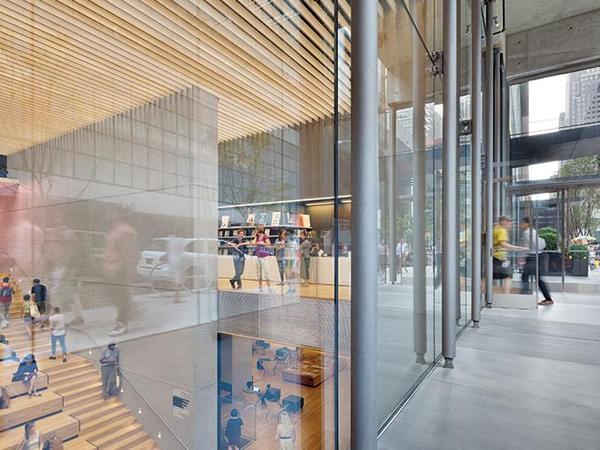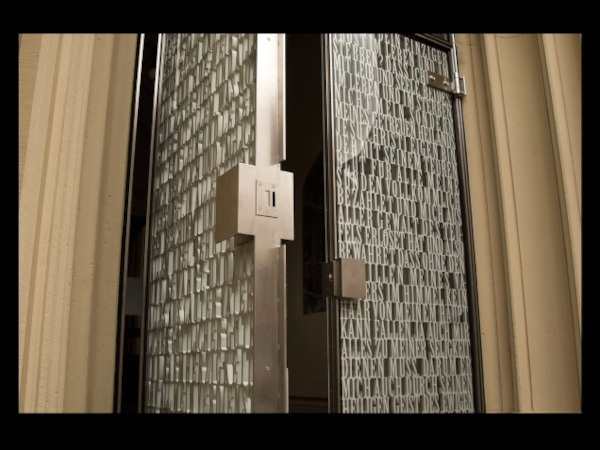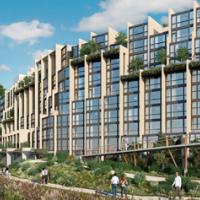
Date: 17 January 2017
Some have said this is the perfect place to be alone – together. The new NYC public library located at 18 West 53rd Street in Midtown, across the street from the Museum of Modern Art is located mostly below street level and features an amphitheater and laptop bar.
They even allow you to bring food inside, so no need to leave for a snack. It could be easily mistaken for an upscale retail outlet or trendy SoHo boutique if it wasn’t for iconic lion in the library’s signature logo right inside the entrance.
As the newest of the New York Library System’s 89 branches, it looks to the future instead of attempting to repair the past.
Replacing the famous Donnell Library Center, a beloved and heavily-used branch of the New York Public Library system, the new library is built below the Baccarat Hotel, a 50-story high rise that occupies much of the square footage where the Donnell Library once stood.
The price tag for the new building is north of $23 million and is squarely focused on the ever changing needs of its patrons.
Not that books are not important today, but libraries are now expected to provide many services such as classes, public programs, and access to electronic books. In short, this library is a departure from any other public library in the city.

Designed by principal architect Enrique Norten and his firm TEN Arquitectos, the library is a subterranean mix of old and new, combining printed literature and technology, and the solitude of being social.
The new space features an amphitheater and an auditorium with TV screens for programs and events, high ceilings, and modern décor. Though two of its three floors are below street level, the library feels bright and spacious, thanks in part to its glassy façade.
Early on, Norten and the general contractor, Turner Construction Corporation, knew the challenge of making a subterranean library appealing. Norten transformed the lower level space for the amphitheater to connect the below-grade spaces with the street above.
To get as much daylight as possible into the main level below ground, Norten not only wanted the façade glazed, but added skylights and several openings in the floors at the rear of the lobby, so that illumination filters down below.
The key was to use a hi-tech glazing system as not only a functional element, but also to make it appealing and not feel like it was a basement. The team chose world-renowned W&W Glass for their expertise in understanding both of these critical aspects.
The design professionals at W&W Glass worked hand in hand with the architects and engineers, to construct a transparent jewel box allowing lots of light to stream into the library. The designers relied on Pilkington Planar™ structural glass systems with a mix of support structures.
Cantilevered laminated glass fins highlight the main front wall and steel substructure backs the interior structural glass walls. The face glass is made of Pilkington Planar™ Optiwhite low-iron SentryGlas® laminated glass.
To anchor the glass back to the structure, glaziers used Pilkington 905 series countersunk bolt fittings. The glass wall face glass extends up in front of an upturned concrete slab at the top and employs an insulating laminated glass return at the head of the wall thus providing a transparent closure. It allows the visitor to look right down through the top of the monolithic wall.
Visitors enter the library from the vestibule on 53rd Street to find the lobby wraps around the amphitheater in a space 34-feet high; elevators are located at the rear to levels below. The grand stairway along the west wall of the stadium seating descends 17-feet to the main reading room.
There, books, desks, and computers extend into the far reaches of this 11,000-square-foot level, which includes the acoustically paneled walls of an enclosed community room that can seat 120 people.
A second, airy staircase, fitted with glass balustrades and open risers, takes visitors down to young-adult reading areas as well as an enclosed children’s reading room under the amphitheater.
The prominence of this space clearly signals that this progressive branch creates more of a community center-type learning environment than a traditional library.
 600450
600450




















Add new comment